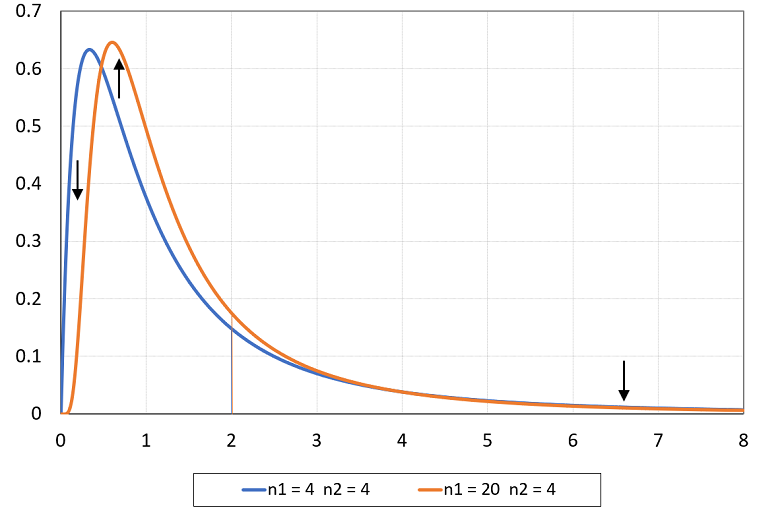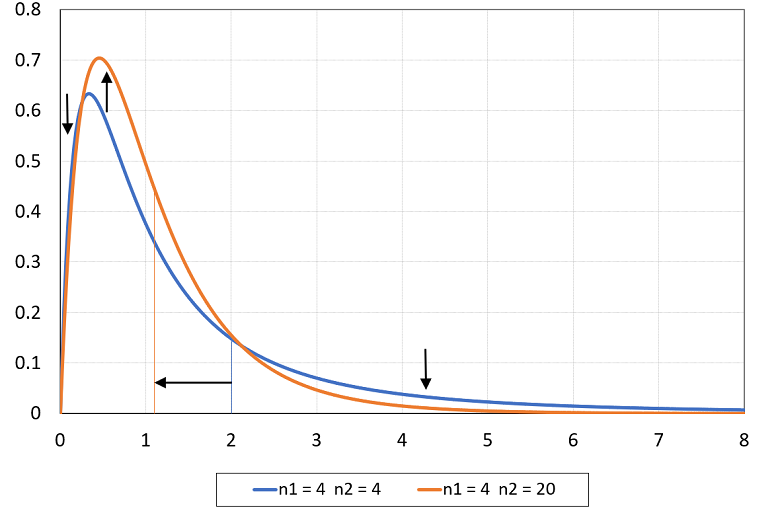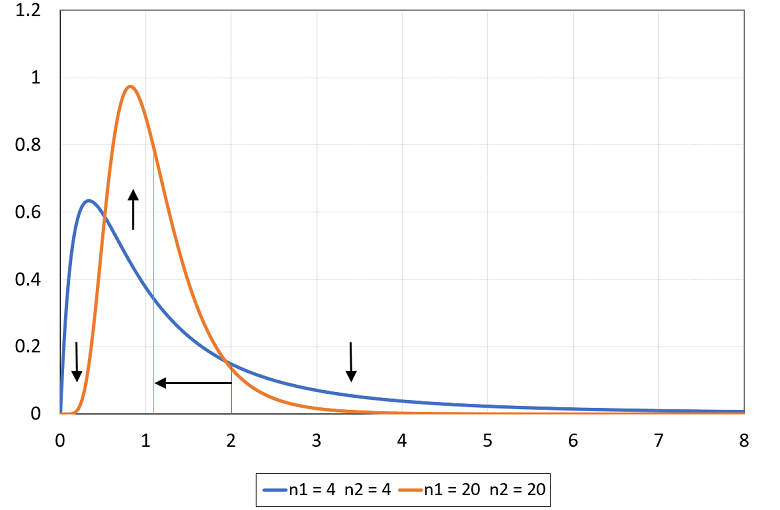The F distribution is a univariate continuous distribution often used in hypothesis testing.
Table of contents
A random variable
has an F distribution if it can be written as a
ratio
between
a Chi-square random variable
with
degrees of freedom and a Chi-square random variable
,
independent of
,
with
degrees of freedom (where each variable is divided by its degrees of freedom).
Ratios of this kind occur very often in statistics.
F random variables are characterized as follows.
Definition
Let
be a continuous
random variable. Let its
support be the set
of positive real
numbers:
Let
.
We say that
has an F distribution with
and
degrees
of freedom if and only if its
probability density
function
is
where
is a
constant:
and
is the Beta function.
To better understand the F distribution, you can have a look at its density plots.
An F random variable can be written as a
Gamma random variable with parameters
and
,
where the parameter
is equal to the reciprocal of another Gamma random variable, independent of
the first one, with parameters
and
.
Proposition
The probability density function of
can be written
as
where:
is the probability density function of a Gamma random variable with parameters
and
:
is the probability density function of a Gamma random variable with parameters
and
:
We need to prove
thatwhere
and
Let
us start from the integrand function:
![[eq14]](/images/F-distribution__36.png) where
where
and
is the probability density function of a random variable having a Gamma
distribution with parameters
and
.
Therefore,
![[eq18]](/images/F-distribution__41.png)
In the introduction, we have stated (without a proof) that a random variable
has an F distribution with
and
degrees of freedom if it can be written as a
ratio
where:
is a Chi-square random variable with
degrees of freedom;
is a Chi-square random variable, independent of
,
with
degrees of freedom.
The statement can be proved as follows.
This statement is equivalent to the
statement proved above (relation to the Gamma distribution):
can be thought of as a Gamma random variable with parameters
and
,
where the parameter
is equal to the reciprocal of another Gamma random variable
,
independent of the first one, with parameters
and
.
The equivalence can be proved as follows.
Since a Gamma random variable with parameters
and
is just the product between the ratio
and a Chi-square random variable with
degrees of freedom (see the lecture entitled
Gamma distribution), we can write
where
is a Chi-square random variable with
degrees of freedom. Now, we know that
is equal to the reciprocal of another Gamma random variable
,
independent of
,
with parameters
and
.
Therefore,
But
a Gamma random variable with parameters
and
is just the product between the ratio
and a Chi-square random variable with
degrees of freedom. Therefore, we can write
The expected value of an F random variable
is well-defined only for
and it is equal
to
It
can be derived thanks to the integral representation of the Beta
function:![[eq24]](/images/F-distribution__79.png)
In the above derivation we have used the properties of the
Gamma function and the Beta function. It is
also clear that the expected value is well-defined only when
:
when
,
the above improper integrals do not converge (both arguments of the Beta
function must be strictly positive).
The variance of an F random variable
is well-defined only for
and it is equal
to
It
can be derived thanks to the usual
variance formula
()
and to the integral representation of the Beta
function:
![[eq27]](/images/F-distribution__86.png)
In the above derivation we have used the properties of the Gamma function and
the Beta function. It is also clear that the expected value is well-defined
only when
:
when
,
the above improper integrals do not converge (both arguments of the Beta
function must be strictly positive).
The
-th
moment of an F random variable
is well-defined only for
and it is equal
to
It
is obtained by using the definition of
moment:![[eq29]](/images/F-distribution__93.png)
In the above derivation we have used the properties of the Gamma function and
the Beta function. It is also clear that the expected value is well-defined
only when
:
when
,
the above improper integrals do not converge (both arguments of the Beta
function must be strictly positive).
An F random variable
does not possess a moment generating
function.
When a random variable
possesses a moment generating function, then the
-th
moment of
exists and is finite for any
.
But we have proved above that the
-th
moment of
exists only for
.
Therefore,
can not have a moment generating function.
There is no simple expression for the characteristic function of the F distribution.
It can be expressed in terms of the Confluent hypergeometric function of the second kind (a solution of a certain differential equation, called confluent hypergeometric differential equation).
The interested reader can consult Phillips (1982).
The distribution function
of an F random variable
iswhere
the
integral
is
known as incomplete Beta function and is usually computed numerically with the
help of a computer algorithm.
This is proved as
follows:![[eq32]](/images/F-distribution__107.png)
The plots below illustrate how the shape of the density of an F distribution changes when its parameters are changed.
The following plot shows two probability density functions (pdfs):
the blue line is the pdf of an F random variable with parameters
and
;
the orange line is the pdf of an F random variable with parameters
and
.
By increasing the first parameter from
to
,
the mean of the distribution (vertical line) does not change.
However, part of the density is shifted from the tails to the center of the distribution.

In the following plot:
the blue line is the density of an F distribution with parameters
and
;
the orange line is the density of an F distribution with parameters
and
.
By increasing the second parameter from
to
,
the mean of the distribution (vertical line) decreases (from
to
)
and some density is shifted from the tails (mostly from the right tail) to the
center of the distribution.

In the next plot:
the blue line is the density of an F random variable with parameters
and
;
the orange line is the density of an F random variable with parameters
and
.
By increasing the two parameters, the mean of the distribution decreases (from
to
)
and density is shifted from the tails to the center of the distribution. As a
result, the distribution has a bell shape similar to the shape of the
normal distribution.

Below you can find some exercises with explained solutions.
Let
be a Gamma random variable with parameters
and
.
Let
be another Gamma random variable, independent of
,
with parameters
and
.
Find the expected value of the
ratio
We can
writewhere
and
are two independent Gamma random variables, the parameters of
are
and
and the parameters of
are
and
(see the lecture entitled Gamma
distribution). By using this fact, the ratio can be written
as
where
has an F distribution with parameters
and
.
Therefore,
Find the third moment of an F random variable with parameters
and
.
We need to use the formula for the
-th
moment of an F random
variable:
Plugging in the parameter values, we
obtainwhere
we have used the relation between the Gamma
function and the factorial function.
Phillips, P. C. B. (1982) The true characteristic function of the F distribution, Biometrika, 69, 261-264.
Please cite as:
Taboga, Marco (2021). "F distribution", Lectures on probability theory and mathematical statistics. Kindle Direct Publishing. Online appendix. https://www.statlect.com/probability-distributions/F-distribution.
Most of the learning materials found on this website are now available in a traditional textbook format.